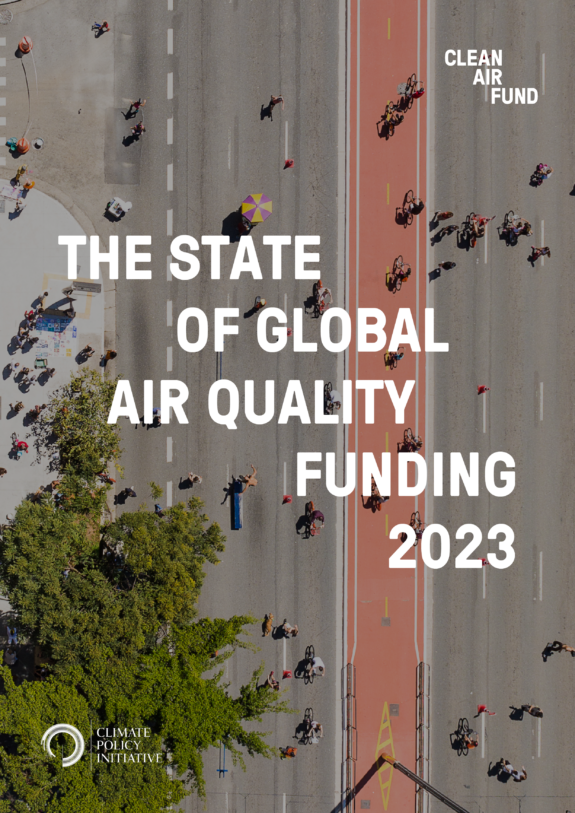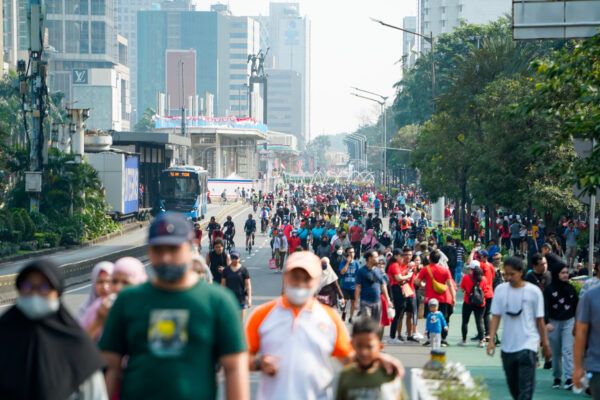
Want to read the latest version of this report? Check out the 2025 edition of The State of Global Air Quality Funding
Air pollution is the largest environmental threat to human health worldwide, causing 7 million premature deaths every year. Air pollution also exacerbates climate change, harms biodiversity and ecosystems, reduces crop yields and workforce productivity, and damages overall economic activity. By investing in clean air, donors can save lives and achieve the Sustainable Development Goals faster.
Our fifth annual report is the only global snapshot of projects funded by international development funders to tackle air pollution. The series maps the outdoor air quality funding landscape, presenting major trends in international development finance flows. The research identifies how donors can maximise their resources for people, planet and economy.
Our goal is to accelerate progress on clean air and arrest the damage that toxic air inflicts on our health and environment. This analysis provides a transparent and robust evidence base for policy makers, funders and campaigners.
In 2015-2021:
1% of international development funding went to clean air projects
2% of international public climate finance went to clean air projects
With the clock ticking towards climate calamity, we must tackle climate change and air pollution together urgently. The science is clear and there are solutions available. We need political commitment and practical action, in order to save lives now and protect the next generation. As the world showed during Covid-19, we can solve big problems when we work together in solidarity towards a common mission.
– foreword by Dr Soumya Swaminathan, former Chief Scientist at World Health Organization (2019-2022), paediatrician and clinical scientist
Key findings:
1. Air quality funding remains too low
Every $1 spent on air pollution control yields an estimated $30 in economic benefits, according to US Environmental Protection Agency.
Yet too many international donors are overlooking and underfunding projects that address air pollution. As this report reveals, only 1% of international development funding ($2.5 billion per year) and 2% of international public climate finance ($1.66 billion per year) was committed to targeting air pollution over the last six years for which full data is available.
What do we mean by development funding?
This report analyses funding from international development funders: multilateral development banks, bilateral development agencies and governments providing funding to low- and middle-income countries in the form of concessional and non-concessional loans, as well as grants. International development funding covers:
- Official development assistance (ODA)
- Other official flows (OOF)
- Flows from other public development funders that are not The Organization for Economic Cooperation and Development
- Development Assistance Committee (OECD-DAC) members (e.g., the Islamic Development Bank).
Our analysis does not quantify the crucial financial support for air pollution reduction provided by national and sub-national government budgets.
2. Top 10 funders tackling air pollution
10 donors provided 97% of total outdoor air quality funding in the last five years for which data is available. This high concentration of funding between a few funders indicates limited engagement with air quality issues. This funding base needs to be expanded to match the scale of this global crisis.
| Ranking | Funder | Outdoor air quality funding ($ million) | Outdoor air quality funding as a % of total finance commitments |
| 1 | Japan | 5,115 | 6% |
| 2 | Asian Development Bank | 5,065 | 5% |
| 3 | Asian Infrastructure Investment Bank | 1,246 | 4% |
| 4 | Canada | 658 | 3% |
| 5 | Republic of Korea | 539 | 2% |
| 6 | World Bank Group | 407 | 0.1% |
| 7 | European Bank for Reconstruction and Development | 299 | 1% |
| 8 | European Investment Bank | 112 | 0.4% |
| 9 | France | 93 | 0.1% |
| 10 | USA | 64 | 0.04% |
| = | All top 10 | 13,597 |
3. Fossil fuel financing overtaken by air quality for the first time
There are signs that the tide is starting to turn on official development assistance supporting fossil fuel usage. The data shows a decline in funding for fossil fuel-prolonging projects since 2019. At its peak that year, $11.9 billion of international development funding was channelled to projects for the extraction and production of oil and gas, threatening the clean air cause and the delivery of global climate goals.
In 2021, for the first time, international development funding for outdoor air quality projects ($2.3 billion) exceeded funding for fossil fuel-prolonging projects ($1.5 billion).
This suggests growing momentum following the commitment to phase down coal-fired power at COP26. Since then, 34 countries and five public finance institutions agreed to stop international public finance for fossil fuels by the end of 2022. If this trend continues downwards, governments at COP28 need to agree on clear strategies for phasing out fossil fuels completely and transitioning to cleaner energy sources fairly and equitably.
4. Untapped opportunities: climate finance and financial instruments
Only 2% of international public climate finance explicitly tackled outdoor air pollution. The causes and consequences of climate change and air pollution are interconnected, and so are their solutions. It is critical to track the benefits of climate interventions on air quality. Monitoring local air quality benefits – particularly in relation to health – can help to deliver a more comprehensive understanding of the effects of global climate interventions, allowing for more informed decision-making and resource prioritisation.
There are a range of financial instruments available to funders with the potential to incentivise and catalyse more funding towards air quality projects. Unharnessed finance vehicles like green bonds, social bonds and results-based funding can create efficiencies and mobilise long-term private capital into air quality projects. So smarter use of these financial instruments by government, international development funders and private investors will catalyse further investment, as the risk is shared.
Which financial instruments are available to donors?
5. Loans prioritised over grants
92% of outdoor air quality funding was provided in the form of loans ($12.9 billion), of which $5.3 billion was low-cost/concessional. Concessional funding is particularly important for low- and middle-income economies who may already be burdened with high debt or are in a debt crisis in the aftermath of the COVID-19 pandemic.
Grants accounted for the remaining 8% of outdoor air quality funding committed in the period, largely from governments (93%). Such funding is vital for facilitating capacity building and technical assistance. Action on air pollution is ultimately a public good and may not develop without the catalytic role of grants. Recipients also favour grants as they avoid worsening debt positions and provide local authorities with more choice in spending.
6. Africa, Latin America and some of Asia left behind
86% of the total $12 billion for air quality was concentrated in China, Philippines, Bangladesh, Mongolia and Pakistan. Meanwhile, other countries in Asia with dangerous levels of air pollution are being overlooked.
Among other gaps, African countries only receive only 5% (or $0.76 billion) of all air quality funding between 2017 and 2021. The continent is home to half of the world’s top ten countries with the highest levels of air pollution. Latin America and the Caribbean received just 1% of the total air quality funding in the same period.
There are gaps at a city-level too. For example, Accra in Ghana, Jakarta in Indonesia and Lima in Peru are well placed to lead the charge if further climate finance is mobilised. At a project level, more funding is needed for air quality modelling, measuring and monitoring, which could create greater efficiencies due to better targeting, and grow the public support and political commitment that are necessary for action.
Recommendations for donors
- Substantially increase the volume of funding for air quality from OECD-DAC donors, whether channelled through multilateral channels or bilaterally.
- Fully account for all benefits (health, climate and sustainable development) that can be delivered through air quality interventions.
- Increase grant and concessional finance and ensure that funding reaches all countries and regions in need. This is particularly important in the context of the debt distress faced by so many countries that receive international aid.
- Multilateral Development Banks can play a critical role in substantially increasing the availability of development finance for air quality. There is a particular role in driving this agenda for the World Bank, whose new president, Ajay Banga, has made access to clean air an explicit part of its remit.
- National policy makers and regulators should track and report on government spending on air quality to increase transparency and assess progress over time. This includes capital mobilised from other sources for projects with air quality co-benefits. For example, private capital could be attracted at scale through innovative financial vehicles, such as Shari’ah-compliant bonds or sukuks, and structured finance mechanisms, such as securitization.
Ultimately, funders and policy makers need to rewrite the script. They must reassess how they finance climate and air quality projects in tandem if we are to live up to the hopes of the Paris Agreement and Sustainable Development Goals. Only then will we see the funding scale up to match both the size of the opportunity and the scale of this pervasive, global problem.
View the full recommendations in the report
Access graphics from the report
You can downloads key graphs from the report from Climate Policy Initiative’s library.

